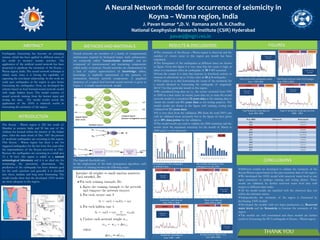
IGU2012_ANN
- 1. A Neural Network model for occurrence of seismicity in Koyna – Warna region, India J. Pavan Kumar *,D. V. Ramana and R. K.Chadha National Geophysical Research Institute (CSIR) Hyderabad pavanj@ngri.res.in Earthquake forecasting has become an emerging science, which has been applied in different areas of the world to monitor seismic activities. The application of the artificial neural network has been proposed to predicate the seismicity of the Koyna – Warna region, India. The neural network technique is widely used, since it is having the capability of capturing the non-linear relationship. In this work we study past earthquakes in the region to give better forecasting the earthquakes. Here, we developed the scheme based on feed forward neural network model with single hidden layers. The model consists of neural network training from the known input and testing the data. The model results reveal the application of the ANN is relatively useful in forecasting the seismicity of the region. The seismicity of the Koyna – Warna region is observed and the number of events occur in this region per month has been calculated. The histograms of the earthquakes at different times are shown in figure. From this figure it is very clear that the count is high, at times it is maximum when an earthquake of M > 4.7 occurred. From the counts it is clear that increase in foreshock activity or increase in aftershock up to 15 days after an M > 4 earthquake. This makes us to that forecasting the count of the seismicity for a month identical to forecasting the earthquake of magnitude M>4.7 for that particular month in this region. We considered long data set i.e., the events occurred from 1990 to 2009 as a time series. In twenty years data set, to train the neural network model we considered 13 years data as the training data to obtain the model and 4½ years data as for testing purpose. The model results are shown in the figure with training, testing and validated for 2½ years data. It is very clear from the validation, 5% from the total 100% can only be validated more accurately but in the figure we have given up to 10% data points for the validation. The model results are used to validate the 2000 seismicity and the results show the maximum seismicity for the month of March in 2000 and it is well observed. Different models are developed to validate the seismicity of the Koyna-Warna region based on the past seismicity data of the region. We developed the ANN model with reservoir water level as one input parameter to undergo training and testing phases. These results are validated, by further reservoir water level data with respect to different time scales. All the model results are matched with the observed data sets within the tolerance errors. Independently, the seismicity of the region is forecasted by developing ANN models. Developed the models with two input parameters i.e., Reservoir water levels and the Seismicity to forecast the seismicity of the region. The models are well constrained and these models are further useful in forecasting the M>5 earthquake in Koyna – Warna region. Neural networks are members of a family of computational architectures inspired by biological brains. Such architectures are commonly called "connectionist systems", and are composed of interconnected and interacting components called nodes or neurons. Neural networks are characterized by a lack of explicit representation of knowledge; rather, knowledge is implicitly represented in the patterns of interactions between network components .A graphical depiction of a typical feed forward neural network is given in Figure 1. A simple neural network model. The Sigmoid threshold unit . In the employment of the back propagation algorithm, each iteration of training involves the following steps: The histograms of the earthquakes at different times. The Koyna reservoir water level changes from 1990 to 2008 Time series of the earthquake counts from 1990-2008 Figure 6 Seismicity count data set from 2000 – 2005 M=5.2 M=5.0 The Koyna - Warna region is 225 km south of Mumbai in western India and 50 km east of the Arabian Sea located within the interior of the Indian plate. After the main shock of Dec. 1967 the present of moderate earthquakes are occurring in this region. This Koyna - Warna region has been a site for triggered earthquakes for the last forty five years after the impoundment of the Koyna reservoir in 1961. Because the earthquakes are occurring in a small area 15 x 30 km2, this region is called as a natural seismological laboratory and it is an ideal site for monitoring the precursory phenomena. The prediction of the earthquake has been ultimate goal for the earth scientists and generally it is classified into short, mediate and long term forecasting. The model results show that the developed ANN models are more adequate in this region. Fig4 Seismicity count data set from 2001-2006 Seismicity count data set from 1990 – 1994 Koyna reservoir Water Level from 2001-2006 The monthly histograms of the earthquakes for year 2005. Seismicity count data set from 1995 to 2000 Water level data set from 1995 to 2000 M =5.0 Year 2005 Observed Forecasted JAN 2 3.237717 FEB 6 5.645138 MAR 39 41.684522 APR 9 8.064301 MAY 20 19.796038 JUN 27 28.059394 JUL 3 3.749682 AUG 1 2.783316 SEP 2 3.237717 OCT 2 3.237717 NOV 7 6.396098 DEC 9 8.064301 THANK YOU